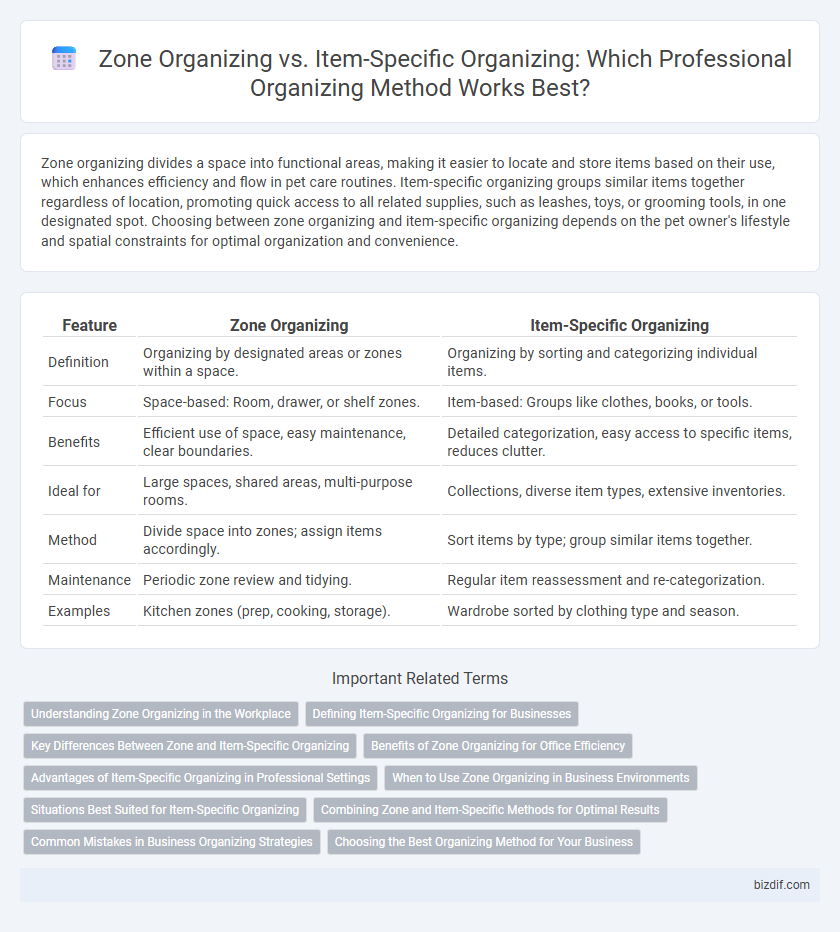Zone organizing divides a space into functional areas, making it easier to locate and store items based on their use, which enhances efficiency and flow in pet care routines. Item-specific organizing groups similar items together regardless of location, promoting quick access to all related supplies, such as leashes, toys, or grooming tools, in one designated spot. Choosing between zone organizing and item-specific organizing depends on the pet owner's lifestyle and spatial constraints for optimal organization and convenience.
Table of Comparison
| Feature | Zone Organizing | Item-Specific Organizing |
|---|---|---|
| Definition | Organizing by designated areas or zones within a space. | Organizing by sorting and categorizing individual items. |
| Focus | Space-based: Room, drawer, or shelf zones. | Item-based: Groups like clothes, books, or tools. |
| Benefits | Efficient use of space, easy maintenance, clear boundaries. | Detailed categorization, easy access to specific items, reduces clutter. |
| Ideal for | Large spaces, shared areas, multi-purpose rooms. | Collections, diverse item types, extensive inventories. |
| Method | Divide space into zones; assign items accordingly. | Sort items by type; group similar items together. |
| Maintenance | Periodic zone review and tidying. | Regular item reassessment and re-categorization. |
| Examples | Kitchen zones (prep, cooking, storage). | Wardrobe sorted by clothing type and season. |
Understanding Zone Organizing in the Workplace
Zone organizing in the workplace involves dividing the office into defined areas based on function or activity, promoting efficiency and reducing clutter. This method enhances productivity by allowing employees to focus on specific zones, such as meeting spaces, workstations, or supply areas, tailored to their needs. Unlike item-specific organizing, zone organizing supports holistic spatial management, facilitating easier maintenance and clearer workflow.
Defining Item-Specific Organizing for Businesses
Item-specific organizing in businesses involves categorizing and arranging materials based on individual items or product types, rather than by physical zones or locations. This method enhances inventory accuracy, simplifies restocking processes, and allows for easier tracking of particular assets or products. By focusing on item-specific organizing, companies can improve operational efficiency and reduce time spent searching for specific items.
Key Differences Between Zone and Item-Specific Organizing
Zone organizing categorizes spaces based on functional areas, such as kitchens or offices, allowing related items to be stored together for efficiency. Item-specific organizing groups belongings by type, like books or clothing, regardless of location, emphasizing sorting by item category. The key difference lies in spatial focus for zone organizing versus item type focus for item-specific organizing, each offering tailored solutions for different organizational goals.
Benefits of Zone Organizing for Office Efficiency
Zone organizing improves office efficiency by grouping related tasks and supplies into designated areas, reducing time spent searching for materials. This method enhances workflow by creating clear, functional zones tailored to specific activities like printing, filing, or brainstorming. Employees experience less distraction and increased productivity as a result of streamlined access and minimized clutter.
Advantages of Item-Specific Organizing in Professional Settings
Item-specific organizing in professional settings enhances efficiency by grouping materials based on function, enabling quicker access to frequently used items such as documents, tools, or digital files. This method reduces clutter by clearly defining storage for each category, promoting a streamlined workflow and minimizing time spent searching. It also supports targeted inventory management, helping maintain adequate supplies and preventing overstock or shortages crucial for business operations.
When to Use Zone Organizing in Business Environments
Zone organizing is ideal in business environments where workflows benefit from spatial grouping, such as departments or project-specific areas, enhancing efficiency and collaboration. It streamlines task management by allocating resources and supplies within designated zones, reducing retrieval times and minimizing clutter. Employ zone organizing when handling inventory, shared equipment, or documents that serve multiple team members to promote accessibility and operational fluidity.
Situations Best Suited for Item-Specific Organizing
Item-specific organizing is best suited for situations where belongings vary widely in function and require tailored storage solutions, such as craft supplies, electronic accessories, or hobby materials. This method enhances accessibility and preserves the unique needs of each item by creating dedicated spaces, which prevents clutter and confusion. It works effectively in environments with diverse categories and fluctuating inventories, supporting efficient retrieval and maintenance.
Combining Zone and Item-Specific Methods for Optimal Results
Combining zone organizing and item-specific organizing creates a hybrid system that maximizes efficiency by grouping related areas while addressing unique storage needs of particular items. This method enhances time management and accessibility by allocating designated zones for broad categories and customizing solutions for individual objects within each space. Integrating both approaches results in a balanced, clutter-free environment tailored to personalized usage patterns.
Common Mistakes in Business Organizing Strategies
Zone organizing often leads to overlapping responsibilities and confusion due to poorly defined boundaries, reducing overall efficiency. In contrast, item-specific organizing can cause fragmented workflows by isolating tasks, making it difficult to maintain a cohesive business process. Common mistakes include neglecting clear categorization criteria and failing to align organizing methods with business goals, resulting in decreased productivity and increased operational errors.
Choosing the Best Organizing Method for Your Business
Zone organizing enhances workflow efficiency by grouping similar tasks or functions based on designated areas, ideal for businesses with distinct operational zones like warehouses or offices. Item-specific organizing targets individual products or materials, optimizing inventory management for businesses focusing on detailed stock control or retail environments. Selecting the best method depends on analyzing your business's operational layout, volume of items, and the nature of tasks to ensure streamlined processes and maximum productivity.
zone organizing vs item-specific organizing Infographic

 bizdif.com
bizdif.com